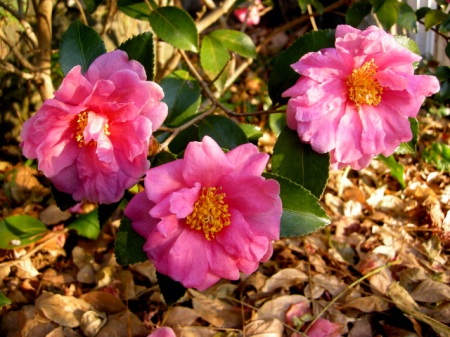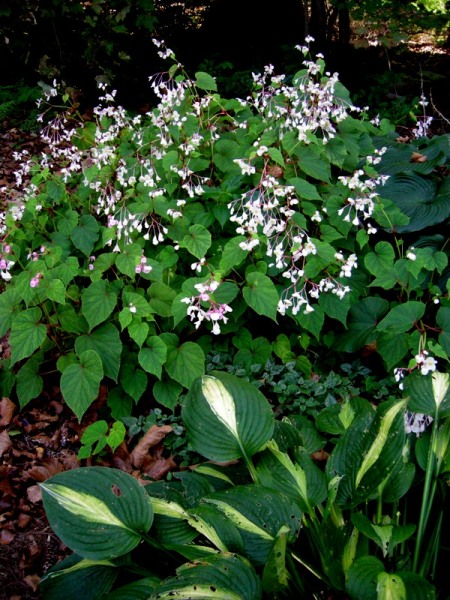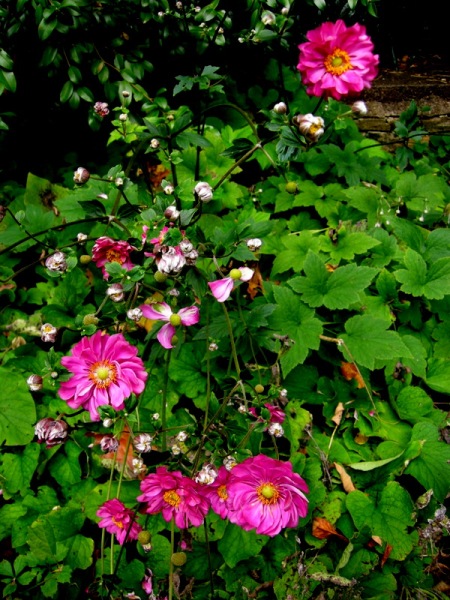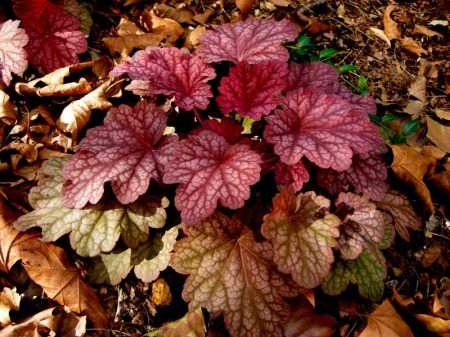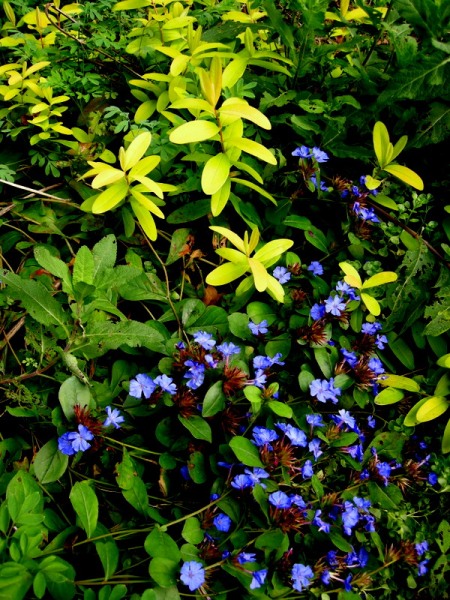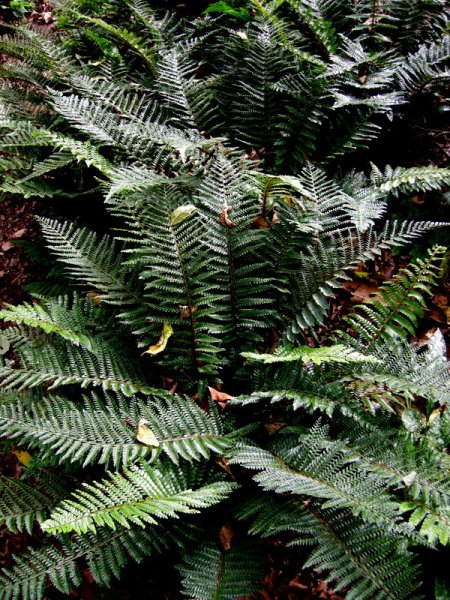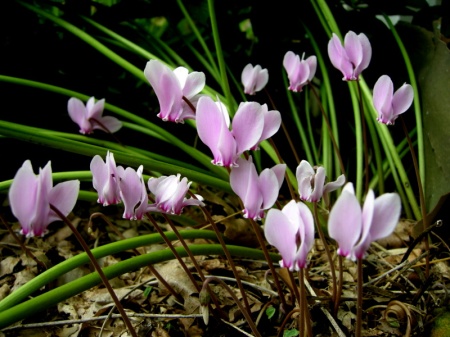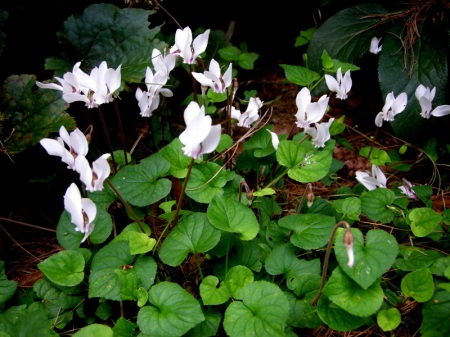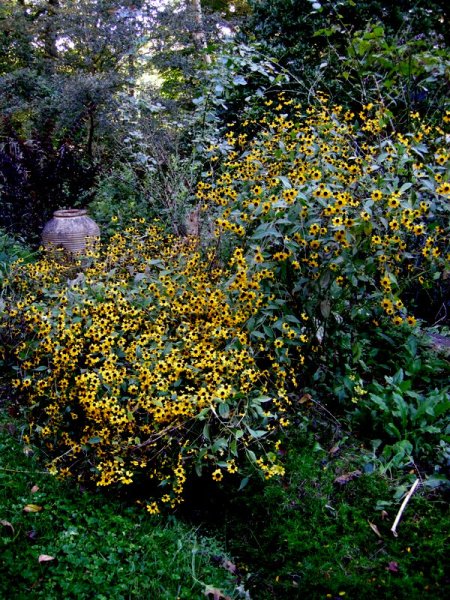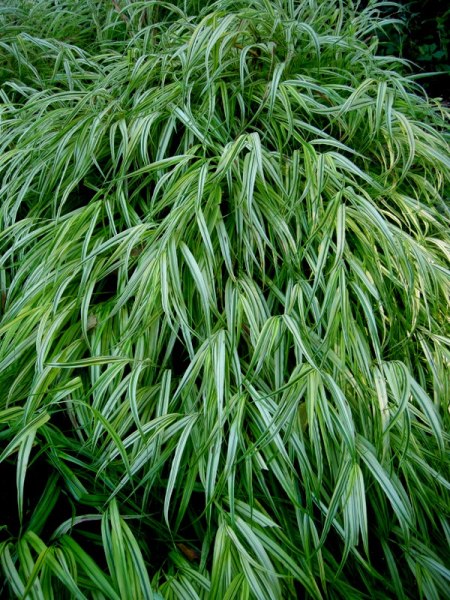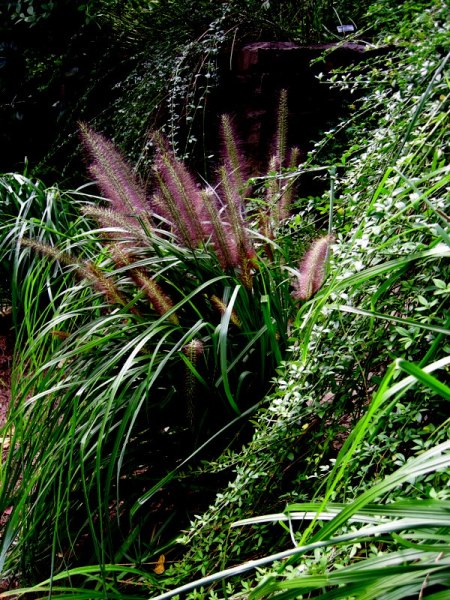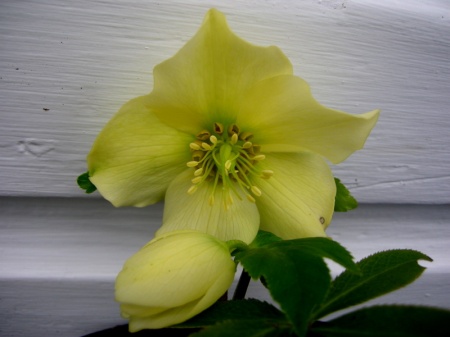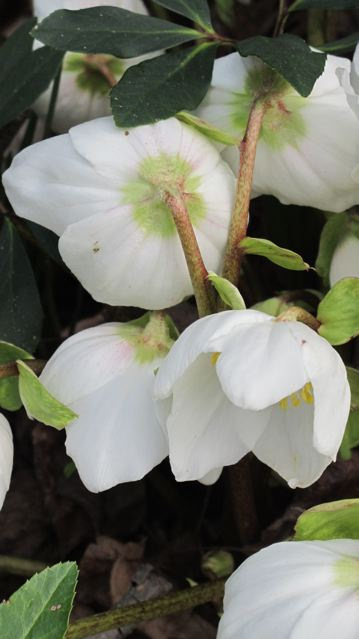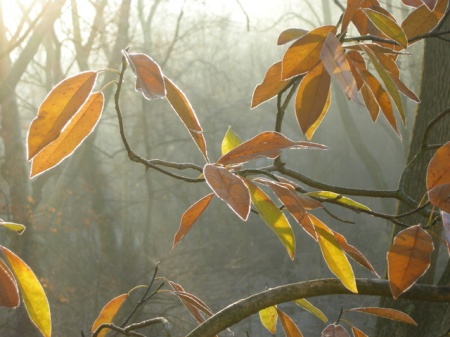 The sunrise lights up the heavy frost outlining the semi-evergreen leaves of native sweetbay magnolia.
The sunrise lights up the heavy frost outlining the semi-evergreen leaves of native sweetbay magnolia.
At Carolyn’s Shade Gardens in southeastern Pennsylvania, US, colorful fall foliage is mostly gone and deciduous trees and shrubs are no longer the focus of garden interest. We must rely on other plants to take over where fall color left off and help us satisfy our goal of providing ornamental interest 365 days a year. At this point, every plant still thriving assumes greater value in the garden, and we look to the understory to draw us outside for a stroll. Here are some of my favorites for December:
Nursery News: Carolyn’s Shade Gardens is a retail nursery located in Bryn Mawr, PA, specializing in showy, colorful, and unusual plants for shade. The only plants that we ship are snowdrops and miniature hostas. For catalogues and announcements of events, please send your full name, location, and phone number (for back up use only) to carolyn@carolynsshadegardens.com. Click here to get to the home page of our website for catalogues and information about our nursery and to subscribe to our blog.
.
![]() The berries of native winterberry hollies stand out in the landscape after their leaves have dropped. In my garden, robins strip the berries fairly early in the season, but I have noticed that in most locations they persist well into the winter.
The berries of native winterberry hollies stand out in the landscape after their leaves have dropped. In my garden, robins strip the berries fairly early in the season, but I have noticed that in most locations they persist well into the winter.
.
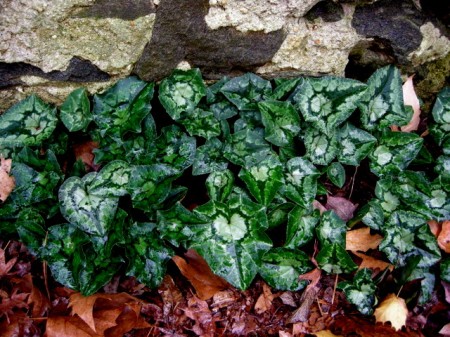 Fall-blooming hardy cyclamen is done blooming, but the leaves are gorgeous all winter. If you look closely, they all have a different pattern like a snowflake. Although I plant them where I want them, they move and thrive in sites of their own choosing. Here they were planted at the front of the bed and moved to the back directly at the base of a stone wall, one of their favorite sites.
Fall-blooming hardy cyclamen is done blooming, but the leaves are gorgeous all winter. If you look closely, they all have a different pattern like a snowflake. Although I plant them where I want them, they move and thrive in sites of their own choosing. Here they were planted at the front of the bed and moved to the back directly at the base of a stone wall, one of their favorite sites.
.
 Here ants moved the cyclamen seeds about 30 to 40 feet up hill all around the base of a gigantic London plane tree where they have filled in and thrived. This is not an area of the garden that I visit often so you can imagine my surprise when I found this display. An Italian arum made the trek too.
Here ants moved the cyclamen seeds about 30 to 40 feet up hill all around the base of a gigantic London plane tree where they have filled in and thrived. This is not an area of the garden that I visit often so you can imagine my surprise when I found this display. An Italian arum made the trek too.
.
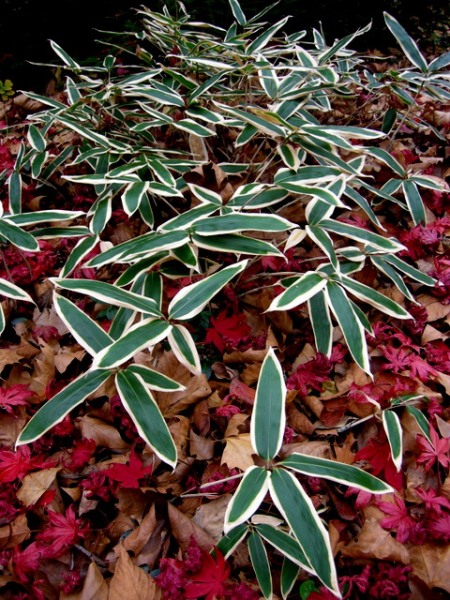 Kuma bamboo grass, Sasa veitchii, has plain green leaves during the season but acquires this elegant white edge for the winter. I planted my sasa over 10 years ago, and this is the first time that it has spread to a decent patch. Generally it is considered quite aggressive.
Kuma bamboo grass, Sasa veitchii, has plain green leaves during the season but acquires this elegant white edge for the winter. I planted my sasa over 10 years ago, and this is the first time that it has spread to a decent patch. Generally it is considered quite aggressive.
.
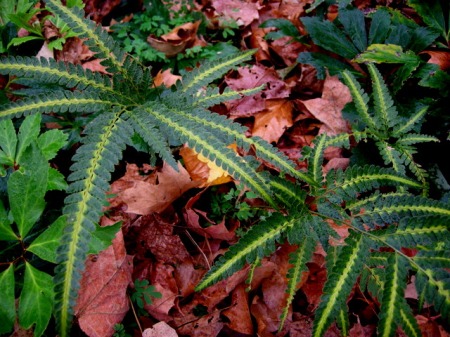 Variegated East Indian holly fern, Arachnoides simplicior ‘Variegata’, is a beautiful evergreen fern. Before you go looking for it though, I think it is borderline hardy here and it doesn’t thrive.
Variegated East Indian holly fern, Arachnoides simplicior ‘Variegata’, is a beautiful evergreen fern. Before you go looking for it though, I think it is borderline hardy here and it doesn’t thrive.
.
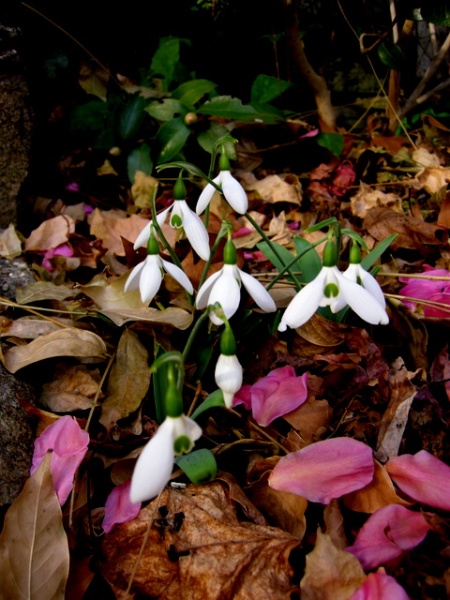 Fall-blooming snowdrops like ‘Potter’s Prelude’ pictured here are a highlight of the fall season starting around October 15 and continuing until early main season snowdrops take over in January.
Fall-blooming snowdrops like ‘Potter’s Prelude’ pictured here are a highlight of the fall season starting around October 15 and continuing until early main season snowdrops take over in January.
.
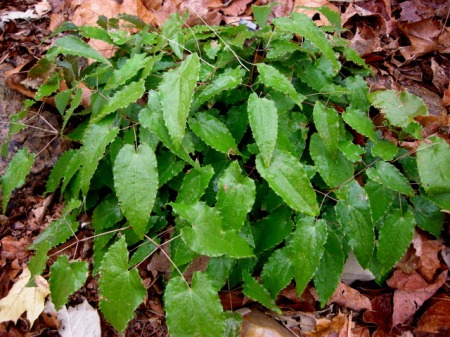 This photo could show any number of my evergreen epimediums, but this is E. stellulatum “Long Leaf Form”. They all have very interesting and attractive leaves which persist until spring when I cut them back.
This photo could show any number of my evergreen epimediums, but this is E. stellulatum “Long Leaf Form”. They all have very interesting and attractive leaves which persist until spring when I cut them back.
.
 Black fountain grass, Pennisetum ‘Moudry’, remains my favorite grass. After a few hard frosts, it turns a lovely tan. It does move around quite a bit but has never gone anywhere that I didn’t want it in 20 years. It is downright invasive for others though, so beware.
Black fountain grass, Pennisetum ‘Moudry’, remains my favorite grass. After a few hard frosts, it turns a lovely tan. It does move around quite a bit but has never gone anywhere that I didn’t want it in 20 years. It is downright invasive for others though, so beware.
.
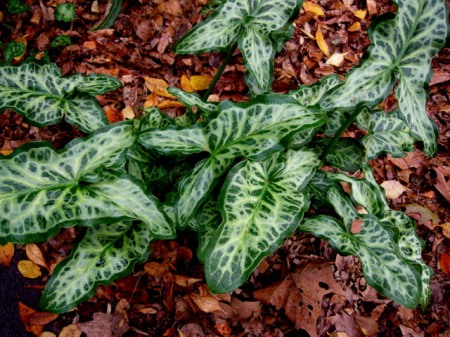 Italian arum stays fresh and beautiful all winter—it goes dormant in the summer instead. This cultivar is ‘Gold Rush’.
Italian arum stays fresh and beautiful all winter—it goes dormant in the summer instead. This cultivar is ‘Gold Rush’.
.
 Another Italian arum with much more white on the leaves—for comparison a typical arum leaf is on the left of the photo. It is possible to get a variety of leaf forms from specialized nurseries.
Another Italian arum with much more white on the leaves—for comparison a typical arum leaf is on the left of the photo. It is possible to get a variety of leaf forms from specialized nurseries.
.
 Chinese fringe trees, Chionanthus retusus, produce lovely dark blue berries in the fall which persist after the leaves drop. This plant is the superior form ‘China Snow’.
Chinese fringe trees, Chionanthus retusus, produce lovely dark blue berries in the fall which persist after the leaves drop. This plant is the superior form ‘China Snow’.
.
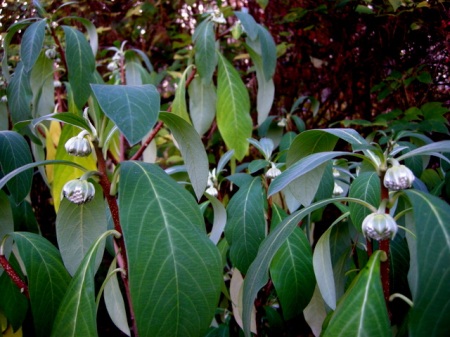 Edgeworthia is beautiful all year round but especially during late fall and winter when the large silver buds start to swell. The leaves turn bright yellow and drop, leaving the bare branches covered with delicate silver ornaments.
Edgeworthia is beautiful all year round but especially during late fall and winter when the large silver buds start to swell. The leaves turn bright yellow and drop, leaving the bare branches covered with delicate silver ornaments.
.
 ‘Winter’s Snowman’ camellia blooms in November and December with large, semi-double white flowers.
‘Winter’s Snowman’ camellia blooms in November and December with large, semi-double white flowers.
.
.
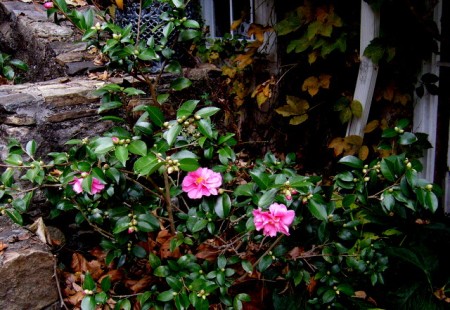 ‘Winter’s Joy’ produces hundreds of buds. When a hard frost turns the open flowers brown, new buds open and flowers cover the plant again as soon as it gets warmer. Although this is usually the case, it didn’t happen during the last two winters when the buds froze early.
‘Winter’s Joy’ produces hundreds of buds. When a hard frost turns the open flowers brown, new buds open and flowers cover the plant again as soon as it gets warmer. Although this is usually the case, it didn’t happen during the last two winters when the buds froze early.
.
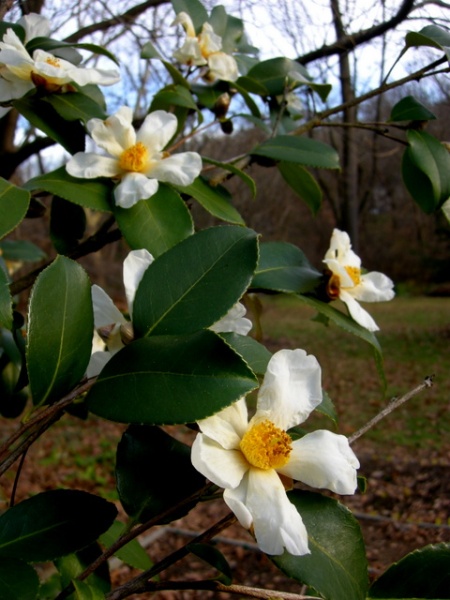 The tea camellia ‘Lu Shan Snow’, C. oleifera, is particularly cold tolerant and has thrived in my garden for almost 20 years. Camellias planted from 2013 on have been very hard to establish in the garden due to our unseasonably cold temperatures during the 2013-2014 and 2014-2015 winters. The camellias that I planted prior to 2013 have all thrived.
The tea camellia ‘Lu Shan Snow’, C. oleifera, is particularly cold tolerant and has thrived in my garden for almost 20 years. Camellias planted from 2013 on have been very hard to establish in the garden due to our unseasonably cold temperatures during the 2013-2014 and 2014-2015 winters. The camellias that I planted prior to 2013 have all thrived.
Carolyn
Nursery Happenings: You can sign up to receive catalogues and emails about nursery events by sending your full name and phone number to carolynsshadegardens@verizon.net. Subscribing to my blog does not sign you up to receive this information.
Carolyn’s Shade Gardens is a local retail nursery in Bryn Mawr, Pennsylvania, U.S., zone 6b/7a. The only plants that we mail order are snowdrops and miniature hostas and only within the US.
Facebook: Carolyn’s Shade Gardens has a Facebook Page where I post single photos, garden tips, and other information that doesn’t fit into a blog post. You can look at my Facebook page here or click the Like button on my right sidebar here.
Notes: Every word that appears in orange on my blog is a link that you can click for more information. If you want to return to my blog’s homepage to access the sidebar information (catalogues, previous articles, etc.) or to subscribe to my blog, just click here.
